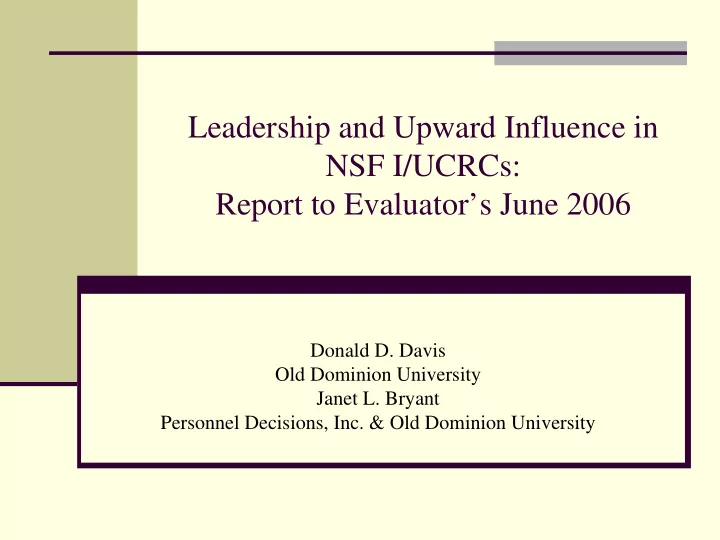

Leadership and Upward Influence in NSF I/UCRCs: Report to Evaluator’s June 2006 Donald D. Davis Old Dominion University Janet L. Bryant Personnel Decisions, Inc. & Old Dominion University
Objectives � Identify leadership relationship and upward influence behaviors that contribute to important outcomes for I/UCRC directors and the university administrators to whom they report � Identify best practices that represent effective leadership relationships and upward influence and share them with center directors (and university administrators?) involved in the NSF I/UCRC program
Leadership and Influence Model Individual Outcomes (e.g., Center Satisfaction, Commitment, Turnover Intentions) Leadership Upward Relationship Influence (LMX, Trust, and Perceived Supervisor Support) Center Performance
Methods � Pilot interviews with 4 center directors � Developed Web-based survey � Emailed invitations to center and site directors � Contacted directors for university administrator information � Emailed invitations to university administrators � Phone and email reminders to directors and administrators
Sample � 126 center directors were invited to respond; 112 responded (88.8%); 96 (76.2%/85.7%) provided usable questionnaires � 85 university administrators were invited to respond; 59 responded (69.4%); 52 (61.2%/88.1%) provided usable questionnaires � 47 centers, 63 universities � 24 single site centers, 23 multi-site centers
Center Director Demographics � Average length of time as center director: 4.20 years � Average length of time in relationship with university administrator: 4.75 years � 13 center directors reported moving their center since its founding
Measures � Leadership relationship: LMX-7 (Graen et al., 1982) � Perceived supervisor support: Survey of Perceived Organizational Support (SPOS) (Eisenberger et al., 1986) � Trust : McAllister (1995) � Leadership relationship (Index containing LMX, perceived supervisor support, and trust) � Influence tactics and influence effectiveness: Influence Behavior Questionnaire (IBQ) (Yukl et al., 1991) � Satisfaction with center, research, IAB: items created for this study � Center commitment: Organizational Commitment Questionnaire (OCQ; Mowday et al., 1979; Porter et al., 1974) � Turnover intentions (intention to quit university, directing center: Michigan Organizational Assessment Questionnaire (MOAQ; Cammann et al., 1983) � Center performance: NCSU evaluation base; performance rating using 5 items created for this study
CD and UA Rater Agreement � Satisfaction with center (r = .34*) � Center commitment (r = .40**) � Upward influence effectiveness (r = .21, ns) � Trust (r = .47**) � LMX (r= .38**)
Center Director Outcomes � Significant direct leadership relationship: � Upward influence effectiveness � Significant leadership relationship partially mediated by upward influence effectiveness (i.e., model predicts accurately): � Satisfaction with center research � Satisfaction with university administrator � Commitment to center � Enhanced R&D � UA perceptions of relationship with CD � Resources provided by UA � Non-significant predictions � Intention to quit directing center or university � NCSU indicators of center performance
University Administrator Outcomes � Significant direct leadership relationship: � Upward influence � Center performance (I/UCRC compared to other centers and directors) � Significant leadership relationship partially mediated by upward influence effectiveness predicts: � Satisfaction with center research � Satisfaction with interactions
Effectiveness of Upward Influence Practices on University Administrator Outcomes (N = 52) 1 � Upward Influence Effectiveness (see Table 1) � Rational persuasion (r = .51**) � Inspirational appeal (r = .44**) � Consultation (r = .42**) � Collaboration (r = .53**) 1 * p < .05, ** p < .01, two tailed test
Effectiveness of Upward Influence Practices on University Administrator Outcomes (cont.) � Satisfaction with I/UCRC � Upward influence effectiveness (r = .36**) � Commitment to I/UCRC � Rational persuasion (r = .36**) � Inspirational appeal (r = .41**) � Consultation (r = .38**) � Upward influence effectiveness (r = .35**)
Effectiveness of Upward Influence Practices on University Administrator Outcomes (cont.) � Center performance rating (I/UCRC compared to other centers and directors) � Rational persuasion (r = .38**) � Apprising (r = .35**) � Inspirational appeal (r = .48**) � Consultation (r = .33*) � Collaboration (r = .31*) � Upward influence effectiveness (r = .43**)
Implementation of Results at JAN 2007 Center Director Meeting � Distribute handout of recommended leadership and upward influence practices to center directors and discuss their use in a breakout session � Collect suggestions for core relationships to examine in new study
New Research � Identify and unpack center director leadership relationships with others � Focus on core relationships and behaviors associated with effective influence � Telephone interviews to discover core relationship behaviors, followed by � Internet survey to rate frequency of behaviors and their impact on outcomes � Submit current final report before submission of new proposal (Submit proposal SEP 2006 to start research JAN 2007)
Recommend
More recommend